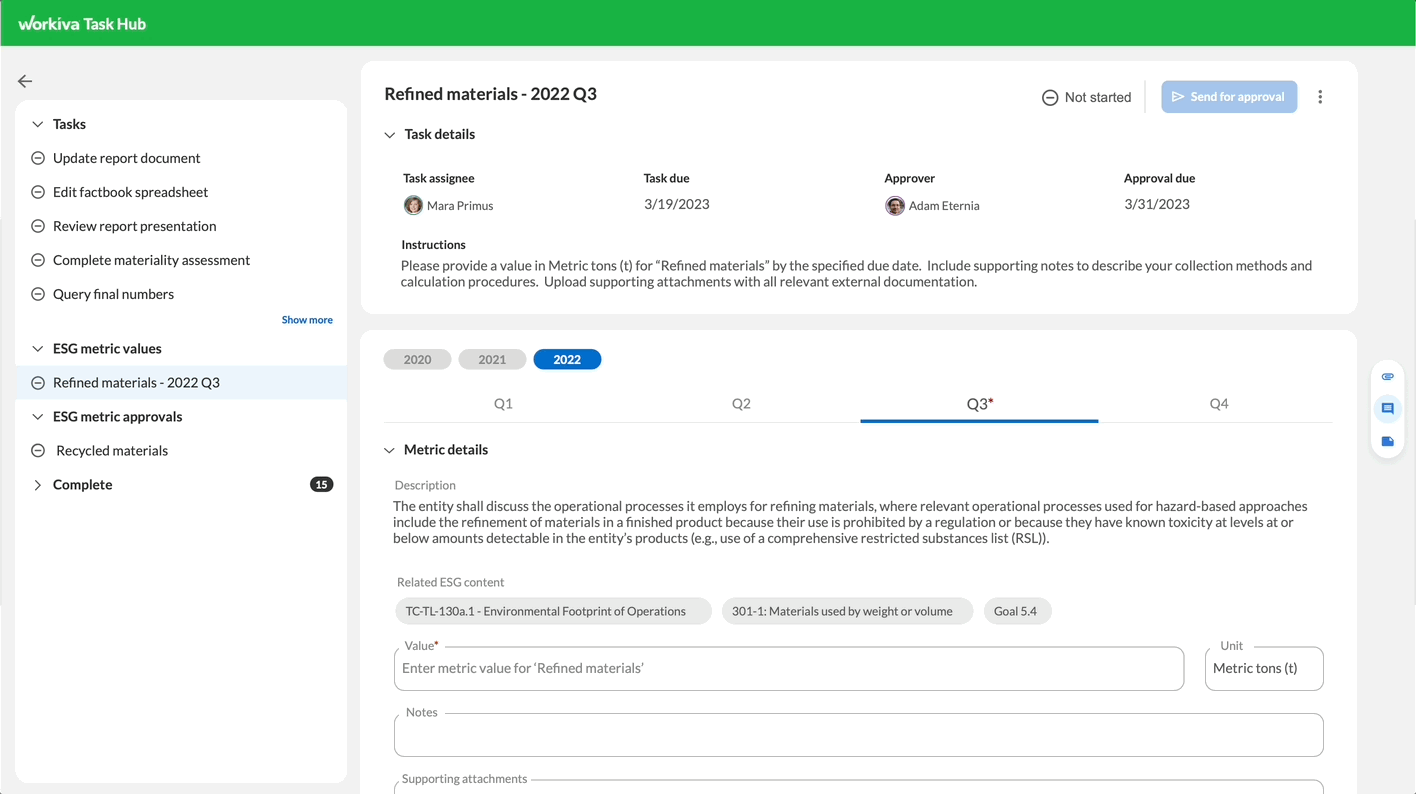COLLECTION PORTAL
The Collection Portal was a breakthrough in data collection for regulatory reporting, dramatically simplifying how organizations gather ESG metrics from hundreds of global contributors. As lead designer, I created a lightweight, purpose-built platform experience that eliminated traditional barriers to enterprise-wide data gathering while ensuring data quality and maintaining regulatory context.
The Challenge
ESG reporting created unique data collection challenges that traditional enterprise systems struggled to address:
Diverse Contributors: Collection from hundreds of stakeholders across global organizations
Participation Barriers: Enterprise login requirements limiting contributor access
Context Gaps: Contributors lacked understanding of regulatory requirements behind requests
Interface Complexity: Traditional enterprise UIs overwhelming occasional users
Communication Friction: Disconnected processes between requestors and contributors
Data Quality Issues: Errors and inconsistencies in submitted information
Design Approach
1. Frictionless Access Architecture
Challenge: Enterprise systems typically required complex login processes, limiting participation.
Solution: Designed a revolutionary authentication model that balanced security with accessibility.
Created secure, tokenized email links bypassing traditional login requirements
Developed personalized landing experiences based on contributor profiles
Designed streamlined onboarding for first-time users
Implemented persistent sessions minimizing re-authentication
Created mobile-optimized interface supporting on-the-go contributions
2. Context-Rich Collection Interface
Challenge: Contributors lacked understanding of why data was being requested and how it would be used.
Solution: Designed an information-rich collection experience that provided regulatory context.
Created expandable framework panels explaining underlying requirements
Developed inline guidance clarifying collection expectations
Designed integrated glossary for specialized terminology
Implemented example libraries showing proper data formatting
Created visual indicators connecting tasks to broader reporting goals
3. Intelligent Form Generation
Challenge: Different metrics required fundamentally different collection interfaces.
Solution: Designed a dynamic form system adapting to specific metric types.
Created specialized interfaces for financial, environmental, and narrative data
Developed dynamic validation appropriate to each data type
Designed progressive disclosure patterns for complex metrics
Implemented smart defaults based on historical submissions
Created embedded calculators for derived metrics
4. Integrated Communication System
Challenge: Traditional workflows created communication silos between requestors and contributors.
Solution: Designed a seamless collaboration system embedded within the collection experience.
Created contextual commenting tied to specific metrics
Developed structured question templates for common inquiries
Designed notification systems for timely responses
Implemented status tracking for conversation threads
Created knowledge capture for recurring questions
Technical Execution
Authentication Innovation: Collaborated with security team on tokenized access model
Cross-Platform Optimization: Designed responsive experience across devices
Form Engine Development: Created dynamic rendering system for diverse metric types
Notification Architecture: Designed intelligent alert system for task management
Data Validation: Implemented real-time quality checking appropriate to each metric
User Impact
Task Portal transformed the data collection experience for both contributors and administrators:
Participation Rates: Increased response rates by 80%+ compared to traditional methods
Time Efficiency: Reduced average completion time by 65% through optimized interfaces
Data Quality: Decreased submission errors by 45% via contextual validation
First-Time Success: 90%+ of tasks completed without support requests
User Satisfaction: Received overwhelmingly positive feedback from global contributors
Business Outcomes
The Task Portal played a critical role in the Sustainability Platform's success:
Scale Enablement: Supported enterprise-wide collection across thousands of contributors
Implementation Speed: Dramatically reduced time-to-value for new customers
Cost Reduction: Eliminated expensive training requirements for contributors
Data Reliability: Improved reporting accuracy through higher quality submissions
Cross-Selling Opportunity: Demonstrated potential for expansion to other Workiva workflows
Design Innovation
The Task Portal introduced several influential design patterns:
Micro-Experience Architecture: Focused, purpose-built interface for occasional users
Context-Embedded Collection: Integration of regulatory knowledge within the collection experience
Dynamic Authentication: Secure access without traditional login friction
Task-Centric Communication: Conversation threads embedded within specific metrics
Progressive Disclosure Forms: Adapting complexity based on metric requirements
The Collection Portal's success demonstrated how thoughtful design could transform what was traditionally the most challenging aspect of ESG reporting—distributed data collection—into a seamless, accessible experience that dramatically improved both efficiency and data quality.
